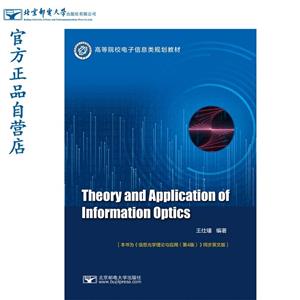-
>
公路车宝典(ZINN的公路车维修与保养秘籍)
-
>
晶体管电路设计(下)
-
>
基于个性化设计策略的智能交通系统关键技术
-
>
花样百出:贵州少数民族图案填色
-
>
山东教育出版社有限公司技术转移与技术创新历史丛书中国高等技术教育的苏化(1949—1961)以北京地区为中心
-
>
铁路机车概要.交流传动内燃.电力机车
-
>
利维坦的道德困境:早期现代政治哲学的问题与脉络
Theory and Application of Information Optics 版权信息
- ISBN:9787563562558
- 条形码:9787563562558 ; 978-7-5635-6255-8
- 装帧:一般胶版纸
- 册数:暂无
- 重量:暂无
- 所属分类:>>
Theory and Application of Information Optics 内容简介
本书系统地介绍了信息光学的基础理论及相关的应用。全书共10章, 内容涉及二维傅里叶分析、标量衍射理论、光学成像系统的频率特性、部分相干理论、光学全息照相、空间滤波、相干光学处理、非相干光学处理, 以及信息光学在计量学中的应用等。本书内容丰富, 选材新颖, 既系统地介绍基础理论, 又同时兼顾理论和技术的发展, 并强调理论与应用的结合。
Theory and Application of Information Optics 目录
Chapter 1Twodimensional Fourier Analysis1
1.1Frequentlyused Several Nonelementary Functions in Optics2
1.2δ Function8
1.3Convolution15
1.4Correlation24
1.5Basic Concept of Fourier Transform28
1.6Basic Theorems of TwoDimensional Fourier Transform35
1.7FourierBessel Transform39
1.8Frequently Used Fourier Transform Pairs42
1.9Linear Systems and Linear Spatial Invariant Systems45
1.10TwoDimensional Sampling Theorem53
Emphasis of This Chapter58
Thinking Questions59
Exercises59
References in This Chapter62
Chapter 2Scalar Diffraction Theory63
2.1Introduction63
2.2Kirchhoff Diffraction Theory65
2.3Frequency Domain Expression of Diffraction Law72
2.4Fresnel Diffraction and Fraunhofer Diffraction77
2.5Calculation Example of Fraunhofer Diffraction81
2.6Calculation Examples of Fresnel Diffraction97
Emphasis of This Chapter102
Thinking Questions103
Exercises103
References in This Chapter106
Chapter 3Frequency Characteristics of Optical Imaging Systems107
3.1Fourier Transform Properties of Lens108
3.2General Analysis of Optical Imaging System118
3.3Transfer Function of DiffractionLimited Coherent Imaging System125
3.4Transfer Function of DiffractionLimited Incoherent Imaging System131
3.5Comparison of Coherent and Incoherent Imaging Systems142
Emphasis of This Chapter146
Thinking Questions146
Exercises146
References in This Chapter149
Chapter 4Partial Coherence Theory150
4.1General Concept of Coherence of Light Field151
4.2CrossCoherence Function160
4.3Interference of QuasiMonochromatic Light166
Emphasis of This Chapter175
Thinking Questions175
Exercises175
References in This Chapter177
Chapter 5Optical Holography178
5.1Basic Principles of Holography178
5.2Fresnel Hologram185
5.3Holographic Recording Media192
5.4Holographic Apparatus and Experimental Notes203
5.5Fourier Transform Hologram207
5.6Image HologramRainbow Hologram213
5.7Volume Hologram218
5.8Embossed Hologram223
5.9Application of Holography227
Emphasis of This Chapter239
Thinking Questions239
Exercises240
References in This Chapter242
Chapter 6Spatial Filtering244
6.1Basic Principles of Spatial Filtering245
6.2Structure Types and Application Examples of Spatial Filter256
Emphasis of This Chapter264
Thinking Questions264
Exercises265
References in This Chapter267
Chapter 7Coherent Optical Processing269
7.1Image Subtraction269
7.2Matched Filtering and Optical Image Recognition273
7.3Using Mellin Transform as Optical Correlation276
7.4Optical Correlation Using Circular Harmonic Transformation279
7.5Halftone Screen Technology281
7.5.1Production of Halftone Pictures281
7.5.2Nonlinear Processing of Image by Halftone Screen282
7.5.3Examples of Image Processing284
7.6Other Coherent Optical Processing285
7.6.1Eliminating Ambiguity with Inverse Filter285
7.6.2Optical Differentiation287
7.7Spatial Light Modulator290
7.7.1Significance and Type of Spatial Light Modulator290
7.7.2Liquid Crystal Light Valve292
Emphasis of This Chapter297
Thinking Questions297
Exercises298
References in This Chapter299
Chapter 8Incoherent Optical Processing301
8.1Comparison of Coherent and Incoherent Optical Processing301
8.2Incoherent Pocessing System Based on Geometrical Optics302
8.2.1Integral Operation of Image Product302
8.2.2Correlation and Convolution of Images303
8.2.3Bipolar Signal Processing Technology306
8.2.4Incoherent Superposition Integral Using Defocusing System306
8.3DiffractionBased Incoherent Processing-Incoherent Frequency Domain Synthesis307
8.3.1Apodisation308
8.3.2Wolter Minimum Intensity Detection Filter310
8.4White Light Information Processing311
8.4.1White Light Information Processing Principle311
8.4.2RealTime Pseudocolor Encoding Technology313
8.4.3θ Modulation Technology316
8.5Phase Modulation Pseudocolor Encoding318
8.5.1Grating Modulation318
8.5.2Bleaching Treatment319
8.5.3Filtering Demodulation319
Emphasis of This Chapter321
Thinking Questions321
Exercises321
References in This Chapter323
Chapter 9Application of Information Optics in Metrology324
9.1The Principle and Basic Method of Holographic Interferometry324
9.2Data Processing Method of Holographic Interferogram334
9.3Speckle Effect and Its Basic Statistical Characteristics344
9.4Recording and Processing of Double Exposure Specklegrams353
9.5Speckle Interferometry363
9.6Basic Concepts of InPlane Moire Method367
Emphasis of This Chapter377
Thinking Questions377
Exercises377
References in This Chapter377
Chapter 10Application of Information Optics in Optical Communication380
10.1Fiber Bragg Grating380
10.2Shaping of Ultrashort Pulse391
10.3Array Waveguide Grating394
Emphasis of This Chapter397
Thinking Questions397
Exercises397
References in This Chapter398
AppendixBessel Function Relation Table399
Theory and Application of Information Optics 作者简介
王仕璠,男,1937年生,电子科技大学教授。1961年毕业于四川大学无线电系,毕业后分配到电子科技大学任教至今。1980年4月至1982年6月,公派赴法国作访问研究,回国后一直从事信息光学的研究和教学工作。出版过著作8种,在国内外发表论文100余篇。1993年起享受国务院特殊津贴。先后担任过电子科技大学应用物理系系主任、国家J科技奖励评审委员、四川省物理学会副理事长、四川省政府参事、成都市政协常委、中国光学学会全息与光信息处理专委会副主任等职。
- >
龙榆生:词曲概论/大家小书
龙榆生:词曲概论/大家小书
¥8.7¥24.0 - >
中国历史的瞬间
中国历史的瞬间
¥16.7¥38.0 - >
伊索寓言-世界文学名著典藏-全译本
伊索寓言-世界文学名著典藏-全译本
¥6.7¥19.0 - >
烟与镜
烟与镜
¥18.3¥48.0 - >
人文阅读与收藏·良友文学丛书:一天的工作
人文阅读与收藏·良友文学丛书:一天的工作
¥15.7¥45.8 - >
经典常谈
经典常谈
¥16.7¥39.8 - >
伯纳黛特,你要去哪(2021新版)
伯纳黛特,你要去哪(2021新版)
¥16.9¥49.8 - >
大红狗在马戏团-大红狗克里弗-助人
大红狗在马戏团-大红狗克里弗-助人
¥5.2¥10.0
-
电机与电气控制技术
¥27.9¥49 -
电工电子技术及应用(第2版)
¥20.5¥39.8 -
通信原理简明教程
¥10.8¥28 -
电子产品工艺
¥23.4¥66 -
配电实用技术 第4版
¥65.3¥99 -
新能源科学与工程应用丛书光伏发电原理.技术及其应用
¥45.9¥69
难选铜镍硫化矿清洁选矿工艺及应用
¥47.4¥58.02014-上海资源环境发展报告-环境保护的公众参与及创新-上海蓝皮书-2014版
¥52.8¥69.0Python量化投资:技术.模型与策略
¥64.2¥79.0作物育种学实验技术
¥50.6¥59.8无死亡是什么
¥26.9¥35.0

















